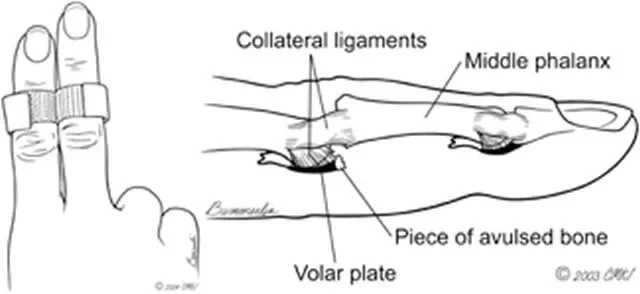
What is a Volar Plate Avulsion Injury?
Volar Plate injuries are often referred to as a “jammed finger”. The Volar Plate can be defined as a very thick ligament that prevents hyperextension from occurring. If there is enough force during hyperextension, the disruption may cause a rupture of the Volar Plate at its insertion on the middle phalanx of a finger. This would result in a small piece of bone from the middle phalanx being avulsed, (pulled off), by the ligament as it is hyperextending. This injury can often involve a collateral ligament tear. Collateral ligaments provide stability from excessive side-to-side motion at the finger joints.
What Causes a Volar Plate Injury?
Volar Plate Avulsion injuries can occur when the proximal interphalangeal (PIP) joint of a finger is hyperextended causing a ligamentous injury. Many of these injuries are frequently seen in athletes, especially ball-handling sports. The collateral ligament injury usually heals without difficulty, although scar tissue formation can occur in the healing of this ligament. The scar formation from the healing collateral ligament often results in enlargement on one side of the PIP joint leading to the appearance of a permanent bulge.
What are the Signs and Symptoms of Volar Plate Injury?
Careful assessment should be performed in determining the severity of the Volar Plate injury. The description of the Volar Plate injury involves either stretching of ligaments, or much more serious, an avulsion fracture (where the ligament has pulled off a piece of bone from the joint surface of the middle phalanx). Signs and symptoms could include: significant swelling or deformity at the joint, pain when the finger is resting, inability to move the joint fully, severe pain with range of motion of the finger. X-rays can help determine an avulsion fracture along with a Volar Plate injury.
What is the Treatment?
Treatment and rehabilitation are important in regaining an optimal outcome. Immobilization of the joint is necessary for a short time. After the first few days of immobilization/splinting, range of motion exercises are to follow to prevent joint stiffness. Range of motion exercises will be explained to you by the UofL Health – Hand Care team. “Buddy taping” the injured finger to a non-injured finger is often recommended to assist in range of motion during the healing period. “Buddy taping” the fingers is recommended 24 hours a day for a short time.
For more information or to schedule an appointment please contact us at 502-561-4263 or 1-800-477-4263. To request an appointment online, use our Appointment Request Form.


